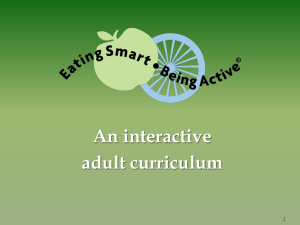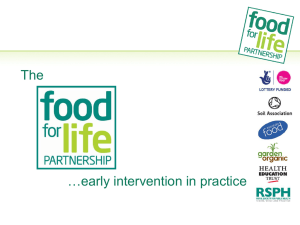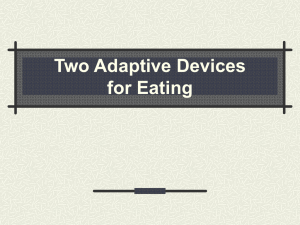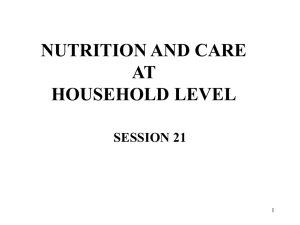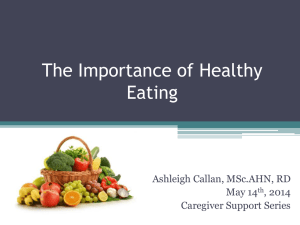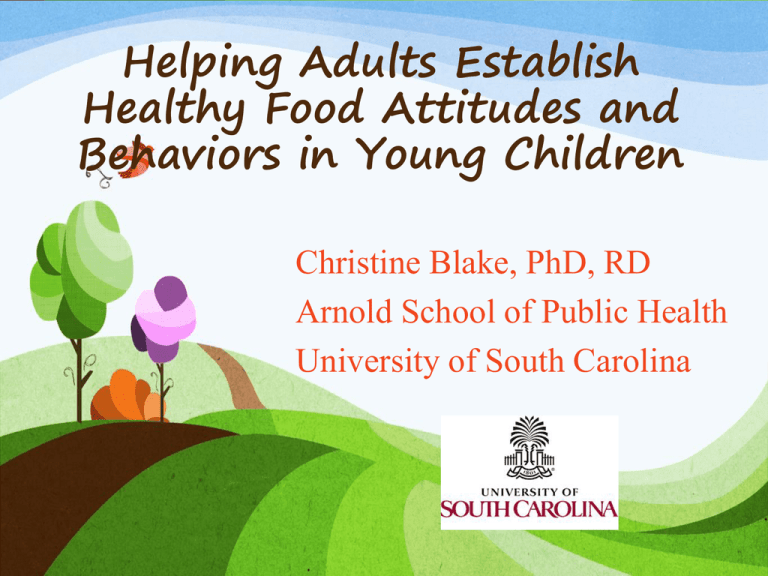
Helping Adults Establish
Healthy Food Attitudes and
Behaviors in Young Children
Christine Blake, PhD, RD
Arnold School of Public Health
University of South Carolina
Outline
• Part 1: Child Caregiver Feeding Styles
• Part 2: Division of Responsibility in Feeding
2
Caregiver Feeding
Styles and
Promoting healthy
eating in children
Dimensions of Parenting
• Based on studies of parenting
• Early parenting studies identified two domains
• Responsiveness
• Control/Restriction
1. Disciplinary strategies
2. Warmth and nurturance
3. Communication styles
4. Expectations of maturity and control
Caregiver Style Definition
“The general pattern of behaviors that a parent
uses to raise his or her children.”
• Combinations of these dimensions yielded four
different styles.
• Authoritative
• Authoritarian
• Permissive
• Uninvolved
Classification of Caregiver Styles
Control
Responsiveness
Demanding,
controlling of
child
Undemanding,
uncontrolling
of child
Accepting of
and responsive
to the child
Rejecting of and
unresponsive to
the child
Authoritative
Authoritarian
Indulgent
Uninvolved
©2008 The McGraw-Hill Companies, Inc. All rights reserved.
Authoritative Caregivers
• Provide a loving, supportive environment
• Hold high expectations and standards for children’s
behaviors
• Enforce rules consistently
• Explain why some behaviors are acceptable and others
not
• Include children in decision making
Authoritarian Caregivers
• Convey less emotional warmth than authoritative
caregivers.
• Hold high expectations and standards for children’s
behaviors.
• Establish rules of behavior without regard for the
children’s needs
• Expect rules to be obeyed without question
• Allow little give-and-take in caregiver-child discussions.
Permissive Caregivers
• Provide a loving, supportive environment.
• Hold few expectations or standards for children’s
behaviors.
• Rarely punish inappropriate behavior.
• Allow children to make many of their own decisions (for
example: about eating, bedtime, etc.).
Uninvolved caregivers
• Provide little if any emotional support for children
• Hold few expectations or standards for children’s
behaviors
• Have little interest in children’s lives
• Seem overwhelmed by their own problems or concerns
Children with Authoritative Caregivers
Tend to be:
• Happy
• Self-confident
• Curious
• Independent
• Likable
• Respectful of others
• Successful in school
• Lower BMI/ lower risk of obesity
• Healthier diets overall
Rhee, Lemung. Pediatrics, 2006; Lemung et al., AJCN 2012
Children with Authoritarian Caregivers
Tend to be:
• Unhappy
• Anxious
• Low in self-confidence
• Lacking initiative
• Dependent on others
• Lacking in social skills and altruistic behaviors
• Coercive in dealing with others
• Defiant
• Increased risk of obesity with authoritarian mothers
• Higher BMI (mixed findings)
• Have lower BMI (only with controlling fathers)
Rhee, Lemung. Pediatrics, 2006; Lemung et al., AJCN 2012
Children with Permissive Caregiver
Tend to be:
• Selfish
• Unmotivated
• Dependent on others
• Demanding of attention
• Disobedient
• Impulsive
• Higher BMI and higher adipocity
• Higher risk of obesity
• Unhealthy eating behaviors
Rhee, Lemung. Pediatrics, 2006; Lemung et al., AJCN 2012
Children with Uninvolved Caregivers
Tend to be:
• Disobedient
• Demanding
• Low in self-control
• Low in tolerance for frustration
• Lacking long-term goals
• Unhealthy eating behaviors
• Higher risk of obesity
Rhee, Lemung. Pediatrics, 2006; Lemung et al., AJCN 2012
Accepting of and responsive
to the child
Responsiveness
Authoritative
•
Demanding,
controlling
of child
•
•
•
Control
•
Provide a loving, supportive, home
environment.
Hold high expectations and standards
for their children’s behaviors.
Enforce household rules consistently.
Explain why some behaviors are
acceptable and others not.
Include children in family decision
making
Indulgent
•
•
Undemanding,
uncontrolling •
of child
•
Provide a loving, supportive, home
environment.
Hold few expectations or standards
for their children’s behaviors.
Rarely punish inappropriate behavior.
Allow their children to make many of
their own decisions (for example:
about eating, bedtime, etc.).
Rejecting of and unresponsive to
the child
Authoritarian
•
•
•
•
•
•
•
•
•
Convey less emotional warmth than
authoritative parents.
Hold high expectations and standards for
their children’s behaviors.
Establish rules of behavior without regard
for the children’s needs
Expect rules to be obeyed without
question
Allow little give-and-take in parent-child
discussions.
Uninvolved
Provide little if any emotional support for
their children.
Hold few expectations or standards for
their children’s behaviors.
Have little interest in their children’s lives.
Seem overwhelmed by their own problems.
Discussion
1. What caregiver styles did you experience as a
child?
2. How did your caregivers influence the way you ate
as a child?
3. How do these experiences influence the way you
eat today?
4. How do these experience influence the way you
feed children today?
16
Division of
Responsibility in
Child Feeding
Caregivers want to know:
How do I get my child to eat?
• The right food
• Dinner
• Vegetables
• Drink milk
• The right amount of food
• Not too much
• Not too little
18
© Ellyn
Satter 2011
The answers
• You can’t get your child to eat
• You can only help your child to
be competent with eating
19
© Ellyn
Satter 2011
A child who is competent with
eating…
• Feels good about eating
• Can learn to like unfamiliar food
• Goes by feelings of hunger and fullness to
know how much to eat
• Enjoys family meals
20
© Ellyn
Satter 2011
A child who is competent with
eating…
• Feels good about eating
Ellyn Satter’s Feeding with Love
and Good Sense II DVD
Segment 2: The Toddler
21
© Ellyn Satter 2011
22
© Ellyn Satter
2011
To let your child feel good about eating…
Accept normal eating behavior
Children are erratic about eating
• Eat a lot one day, a little the next
• Not a square meal… only two or three foods
• Tire of even favorite foods and experiment
with new food
• Rarely eat a new food the first time they
see it
• …except for candy and French fries!
23
© Ellyn
Satter 2011
A child who is competent with
eating…
• Feels good about eating
• Can learn to like unfamiliar food
Ellyn Satter’s Feeding with Love
and Good Sense II DVD
Segment 2: The Toddler
24
© Ellyn
Satter 2011
25
© Ellyn Satter
2011
FEEDING PRESSURE BACKFIRES
Forcing, bribing, coercing, nudging,
applauding, rewarding, explaining,
teaching, restricting
• Getting children to eat certain foods
• Getting children to eat more or less
• Getting children to avoid certain foods
Secrets of Feeding a Healthy Family
Appendix I: Children and food regulation—the research
26
© Ellyn
Satter 2011
FEEDING PRESSURE BACKFIRES
Forcing, bribing, coercing, nudging,
applauding, rewarding, explaining,
teaching, restricting
• Getting children eat certain foods
90% of caregivers
• Getting children
to eatchildren
more or less
pressure
to eat
• Getting children
to avoid certain foods
50% of children
have feeding
problems
27
© Ellyn
Satter 2011
A child who is competent with
eating…
• Feels good about eating
• Can learn to like unfamiliar food
• Goes by feelings of hunger and fullness
to know how much to eat
Ellyn Satter’s Feeding with Love
and Good Sense II DVD
Segment 2: The Preschooler
28
© Ellyn Satter 2011
29
© Ellyn Satter
2011
FOOD RESTRICTION BACKFIRES
Children become afraid of going hungry
and overeat when they get the chance
•
Getting children to eat certain foods
•
Getting children to eat more or less
•
Depriving children of certain foods
•
Not letting children eat as much as they are hungry for
30
© Ellyn
Satter 2011
FOOD RESTRICTION BACKFIRES
Children become afraid of going hungry
and overeat when
theywho
getget
the
Children
thechance
message they are too
fateat
feelcertain
flawedfoods
in every
• Getting children
way—not smart, not
• Getting children
to eat more
or less
physically
capable,
and
not worthy.
• Getting children to avoid certain foods
They tend to diet, gain
weight, and weigh
more than they would
otherwise.
31
© Ellyn
Satter 2011
A child who is competent with
eating…
• Feels good about eating
• Can learn to like unfamiliar food
• Goes by feelings of hunger and fullness to
know how much to eat
• Enjoys family meals
Ellyn Satter’s Feeding with Love
and Good Sense II DVD
Segment 2: The Transitional Child
32
© Ellyn
Satter 2011
33
© Ellyn Satter
2011
Children with regular family meals
do better
• Nutritionally, socially, emotionally,
academically & with respect to
resistance to overweight, drug &
alcohol abuse and early sexual behavior
• Family meals are more instrumental in
positive outcome than SES, family
structure, after-school activities,
tutors, or church
Secrets of Feeding a Healthy Family
Appendix B: What the research says about meals
34
© Ellyn
Satter 2011
How do you help children
become competent with
eating?
35
© Ellyn
Satter 2011
From birth, and throughout
your child’s growing-up years…
Maintain a division of
responsibility in
feeding
36
© Ellyn
Satter 2011
Infant
Division of Responsibility
• Parent: What
• Child: How much
Satter, JADA 86:352-356, 1986
37
© Ellyn
Satter 2011
Toddler through adolescent
Division of responsibility
• Parent: What, when, where
• Child: How much, whether
Satter, JADA 86:352-356, 1986
38
© Ellyn
Satter 2011
Do your jobs with
feeding
• Have regular meals and snacks
• Choose and prepare food
• Make eating time pleasant
• Show your child what to learn
• Accept and support your child’s growth
39
© Ellyn
Satter 2011
After you do your jobs with
feeding, trust your child to
do his or her jobs with
eating
• Feel good about eating
• Learn to like unfamiliar food
• Eat the right amount to grow properly
• Enjoy family meals
40
© Ellyn
Satter 2011
Sort out feeding jobs
41
© Ellyn
Satter 2011
42
© Ellyn Satter
2011
43
© Ellyn Satter
2011
Discussion
• What did you discover?
• What did Gage’s caregivers do well?
• Where did they have trouble?
• Did Gage do his jobs with eating? Why not?
44
© Ellyn Satter
2011
Structure is essential.
45
© Ellyn
Satter 2011
Get the meal habit
Be considerate, don’t cater
For children and other people
• Offer everyone the same meal
• Choose food you find rewarding
• Offer a number of foods
• Pair foods
• Familiar foods with unfamiliar
• Favorite with not-so-favorite
46
© Ellyn
Satter 2011
Offer structured sit-down snacks
• Avoid grazing and food or drink handouts
• Time snacks so they don’t interfere with
meals
• Make snacks “little meals” with 2-3 foods
• Include “forbidden food”
http://www.ellynsatterinstitute.org/
47
© Ellyn
Satter 2011
Feeding your child will help you feed
yourself
You can be competent with eating
Feel good about eating
Know how to sneak up on new food and
learn to like it
Go by your feelings of hunger and fullness
to know how much to eat
Provide yourself with regular, reliable, and
rewarding meals and snacks
48
© Ellyn
Satter 2011
Learn more about feeding and
eating
… and the evidence that
supports it
• Part 1: How to eat
• Part 2: How to raise
good eaters
• Part 3: How to cook
Also see
www.EllynSatter.com
49
© Ellyn
Satter 2011
Getting your child started
right with eating is a gift
that lasts a lifetime.
50
© Ellyn Satter 2011
Group Discussion
1. What are the feeding issues that you encounter
in your work?
2. What feeding issues are most difficult to deal
with?
3. What feeding issues have you handled well?
4. What will you do differently in the future?
51
Summary
• Promote age-appropriate foods and beverages
• Develop healthy caregiver feeding styles
• Practice the division of responsibility in feeding
• Caregiver decides what, when, and where
• Child decides whether to eat and how much to eat
52
© Ellyn Satter
2011
Questions or
Comments?
53




